We may earn revenue from the products available on this page and participate in affiliate programs. Learn More ›
IN CELEBRATION of its 100th anniversary, Griffin & Howe decided to build a small number of rifles worthy of the occasion. As you can see in the photographs, they are stunners—but there’s more to these beauties than meets the eye. These inspired creations commemorate not only the founding of the illustrious gun company but also its special connection to Townsend Whelen and Outdoor Life.
That’s a lot to take in, so allow me to dial the clock back to the early decades of the 20th century.
Whelen—most often referred to as Colonel Townsend Whelen—was a career Army officer who loved hunting the wilderness and had a deep appreciation of fine rifles, ballistic innovation, and the art of precision marksmanship. He communicated these passions with a clear, straightforward writing style that earned him a wide following and eventually the unofficial title of dean of the outdoor writers.
His most enduring legacies are the statement that only accurate rifles are interesting—which was the title of a story he wrote for American Rifleman in 1957—and the cartridge that bears his name: the .35 Whelen.
Little surprise that a man of his (ahem) caliber was one of the first shooting editors of Outdoor Life, a position he held for many years before passing the mantle to Jack O’Connor.
By way of context, since 1898, the year of OL’s founding (we’re celebrating our 125th anniversary this year), we’ve only had five shooting editors. In order, they are: Charles Askins Sr., Col. Townsend Whelen, Jack O’Connor, Jim Carmichel, and your humble correspondent.
The Genesis of Griffin & Howe
Whelen started writing for Outdoor Life around 1906 and contributed to the publication well into the 1930s. At some point during the 1910s, he caught wind of a talented stock maker, Seymour Griffin, who had built a reputation for turning homely government-issue Springfield 1903s into lovely sporting pieces.
Whelen was already an influential force in the development of sporting and military arms and munitions by that time. His day job was director of research and development at Springfield Armory and commanding officer of Frankford Arsenal.
In 1921, Whelen met James Howe, a gunmaker and foreman of the Frankford Arsenal machine shop. Together they started working on a new family of cartridges based on a .30/06 necked up to different diameters, including .400, .375, and .35. Of these “Whelen” cartridges, only the .35 Whelen made significant inroads with the shooting public—and even so, it remained a wildcat from 1922 until 1988, when Remington finally offered it as a commercial load.
Whelen introduced Griffin and Howe and urged them to go into business together. Acting as an official advisor, he helped them procure financing.
Griffin & Howe, a sporting goods store and custom gunmaker, opened on June 1, 1923, at 234 East 29th Street in New York City. Though his name isn’t on the company’s trademark, Whelen is rightfully acknowledged as one of Griffin & Howe’s founders.
The business quickly grew, and Griffin & Howe developed a worldwide reputation for making fine hunting rifles; it soon became one of the premier sources for hunters and sportsmen looking to get outfitted for adventure. Its clientele included Ernest Hemingway, Robert Ruark, Gary Cooper, Clark Gable, Bing Crosby, President Dwight Eisenhower, and other luminaries.
Over the past 100 years, the company has had its share of ups and downs but continues to endure. Today, its home base is Hudson Farms in Andover, New Jersey, and it is under the directorship of company president and CEO Steven Polanish.
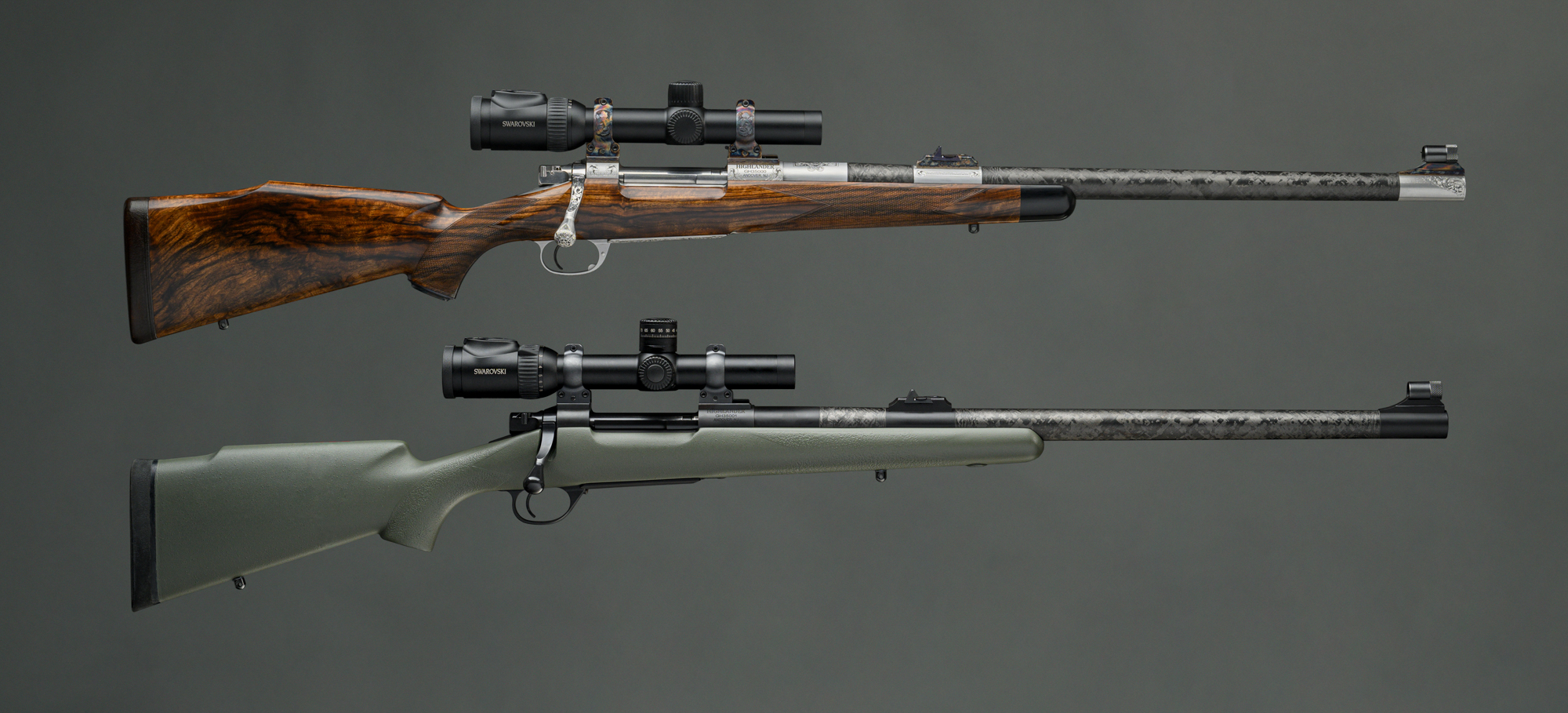
A Perfect Pair
About eight years ago, Griffin & Howe expanded its rifle line with the introduction of the Long-Range Precision Rifle and since then has added the Highlander and All-American models.
The rifles here are Highlanders, which are built on control-round feed actions produced by Defiance Machine and have a classic three-position safety mounted on the bolt shroud.
Both rifles are chambered in .35 Whelen, naturally, and blend traditional design elements with interesting innovation.
Because of Whelen’s role in getting Griffin & Howe off the ground and his position at Outdoor Life, OL and G&H have always enjoyed a strong connection and friendship. It’s a relationship that’s lasted throughout the decades and is the reason I was able to get a first look at these special guns.
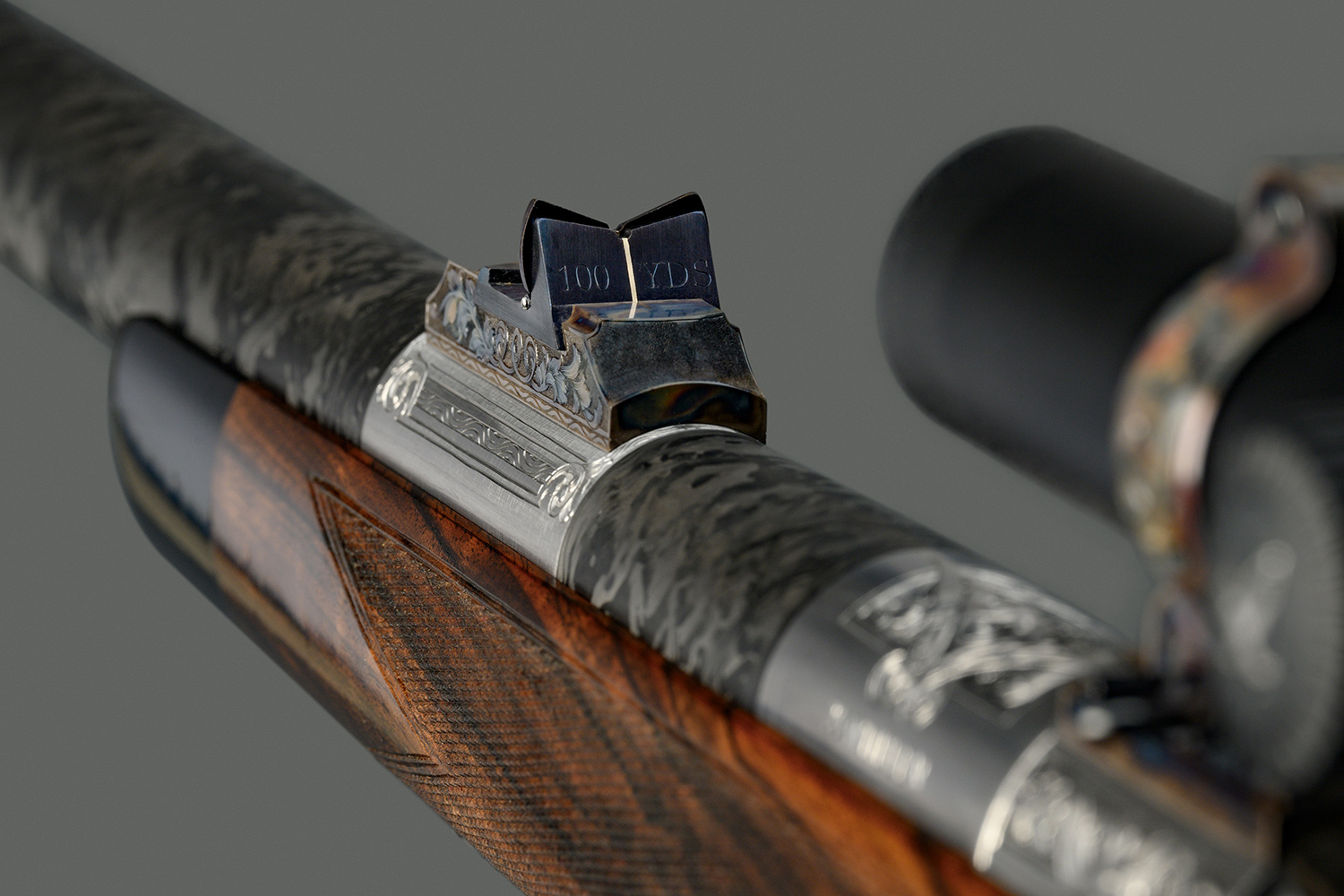
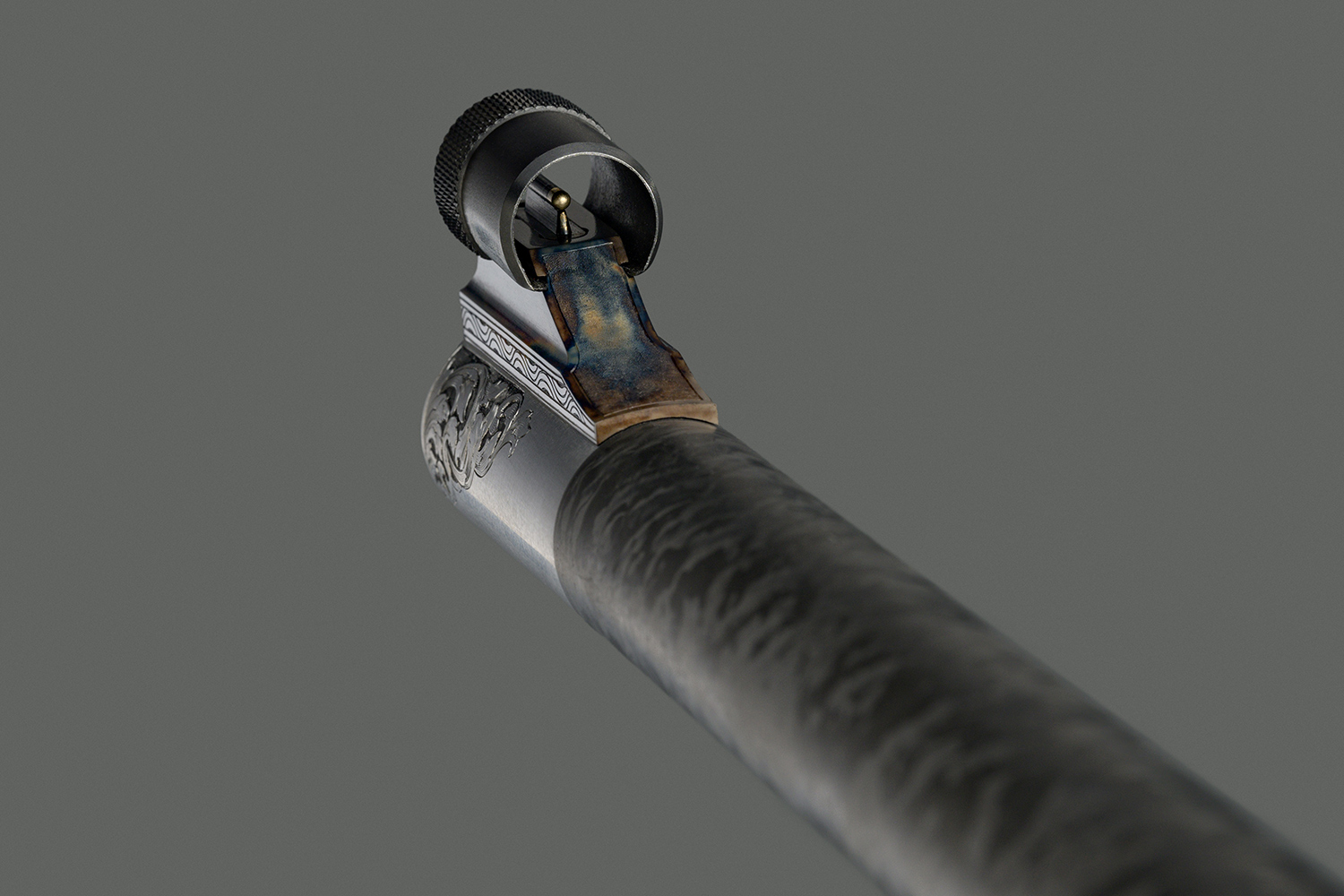
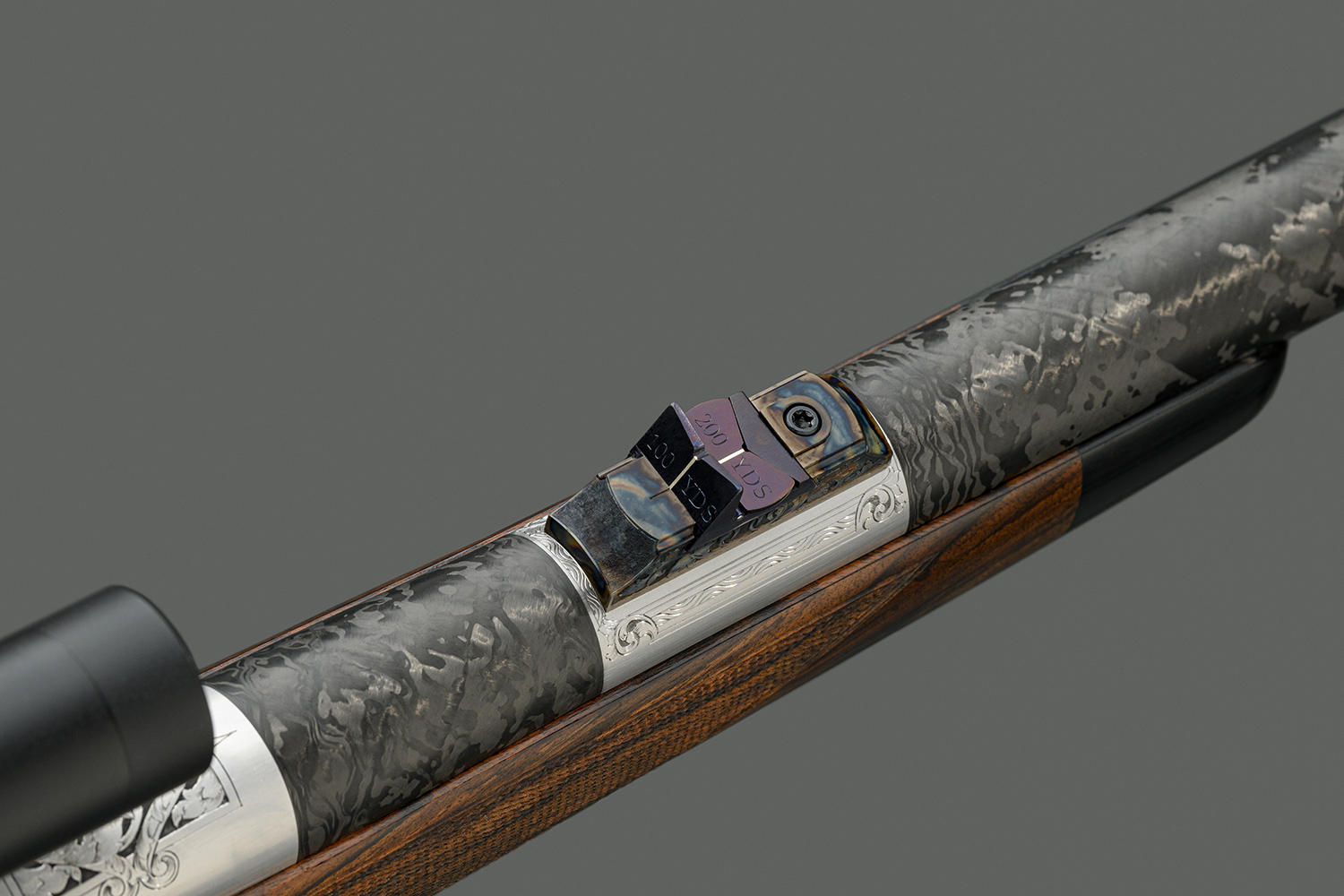

Unique Sights
The carbon-fiber barrels, which are made by Proof Research, may have caught your eye. They were constructed to accommodate an island rear sight, which, to the best of my knowledge, has never been done on a carbon-fiber barrel before, and certainly never as a standard offering.
These sights are a thing of beauty. They’ve been regulated to hit spot-on at 100 yards and have a single leaf that flips up for 200-yard shots.
While I spent a lot of time shooting these rifles for accuracy off the bench with the Swarovski Z8i 1-8x24s they came with, I couldn’t wait to pull the optics off—both rifles feature Griffin & Howe’s proprietary quick-detach scope mounts—and run them with open sights.
I was able to easily ring the 10-inch gong at 100 yards with every shot. The bead on the front post is protected by a sturdy shroud and settled nicely into the notch of the shallow “V” formed by the rear sight. A vertical white line running up the middle of the rear sight helps the shooter center the front bead precisely in the notch.
When I moved to 200 yards, it took me a couple shots to spot my bullet impact—I was hitting a bit high—but I made the adjustment and went two for three at that distance.
In my mind’s eye I was no longer at a shooting range, but rather I was hunting in East Africa back in the 1950s, putting down a Thomson’s gazelle for camp meat or stalking close to a kudu bull crowned with horns spiraling toward the heavens.
Not many rifles can transport a shooter that way, but these do. A rifle bearing the Griffin & Howe name, chambered in the Whelen, and topped with nothing more than crisp and effective open sights, was something to aspire to back in the day. It still is.
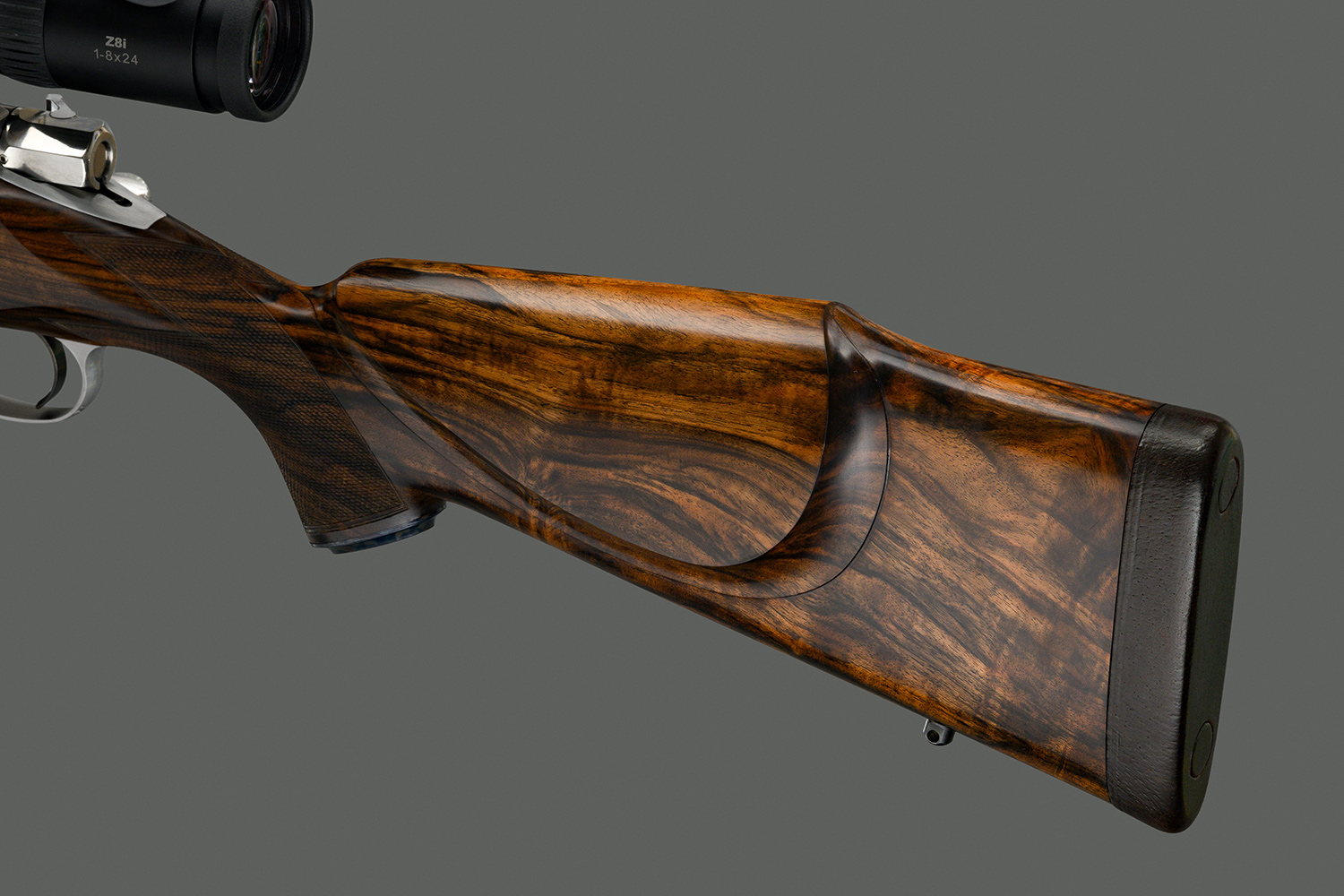
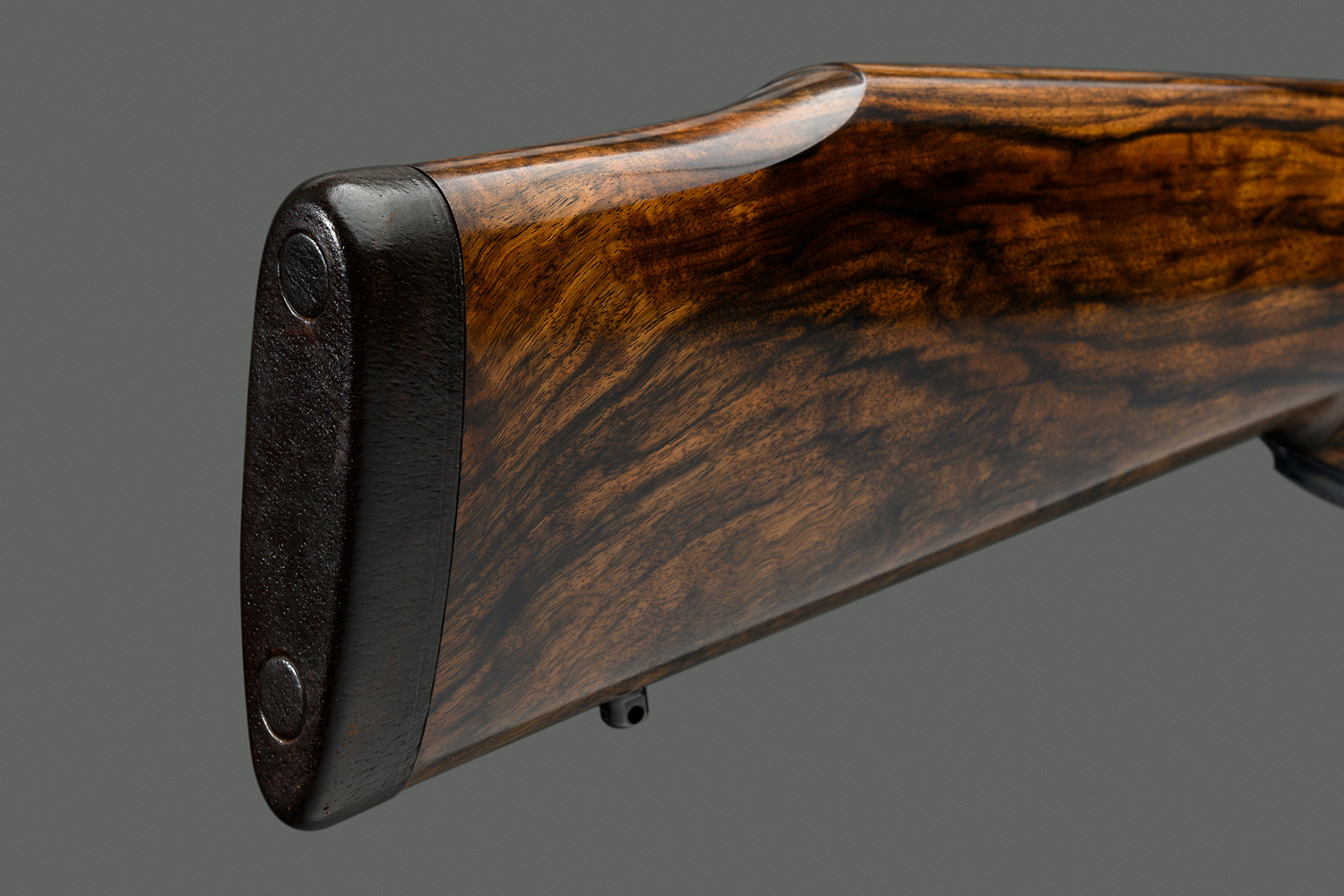
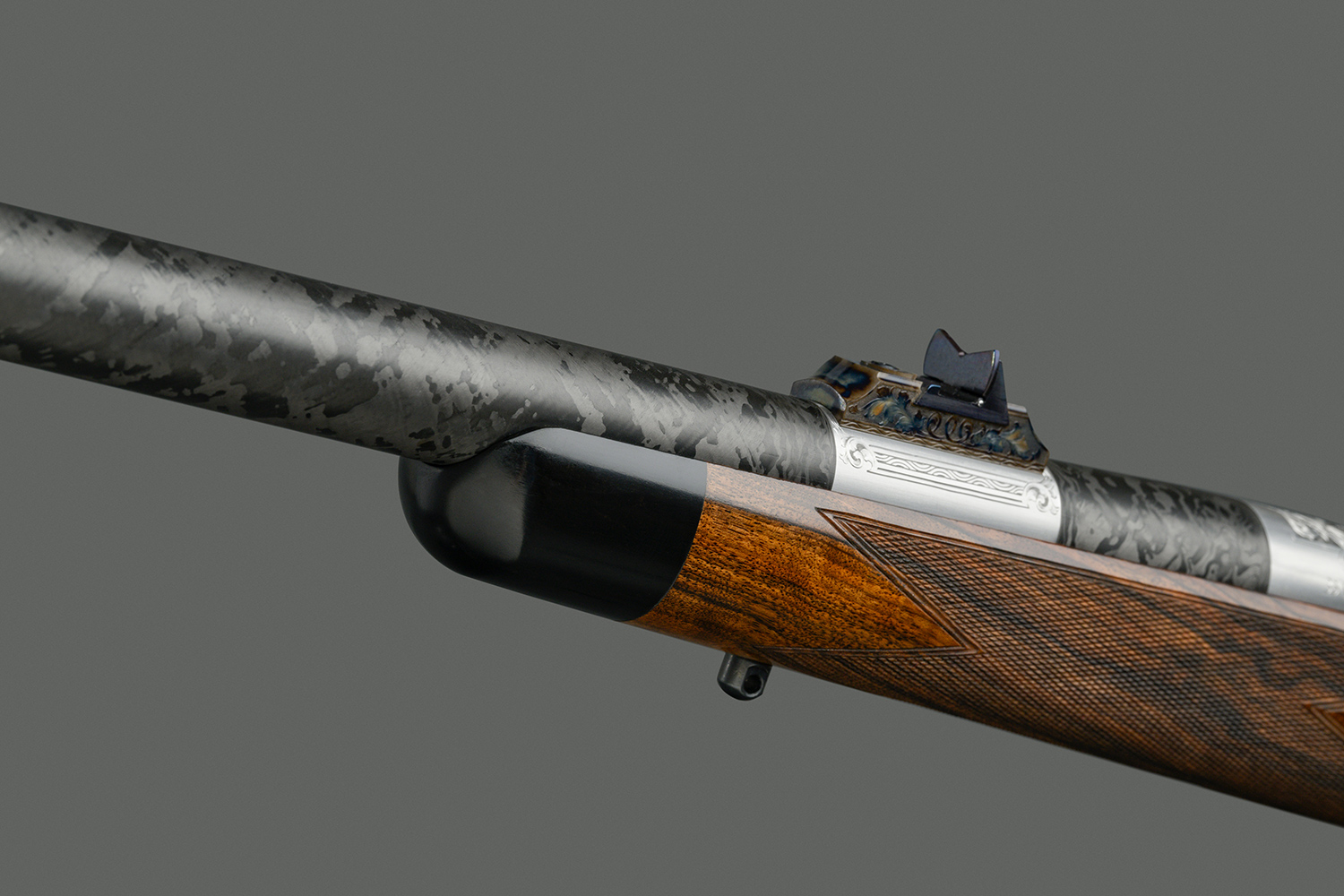
Wonderful Wood
The rifle with the composite stock is built for hard work and is pleasant enough to look at for a gun of that type, but it pales in comparison to the glorious wood on the other rifle.
The French walnut that Polanish selected—he purchased both of these rifles, which have serial numbers GH35000 and GH35001—is a great canvas on which to showcase the stock maker’s art.
The stock maker in question is Dan Rossiter, the shop foreman at Griffin & Howe and a member of the prestigious American Custom Gunmakers Guild.
The hand-cut checkering is perfect, with the diamonds on the fore-end and grip in line with the border, as it is supposed to be.
The raised Monte Carlo cheek piece, with its negative comb, is outlined with a sharp and attractive shadow line. The ebony tip on the fore-end and leather recoil pad bookend the highly figured wood, completing the elegant execution of the stock.
The grip was cut with a slight palm swell. It isn’t enough to distract from the rifle’s classic lines, but it is a nice modern ergonomic enhancement that shows how the old and new can coexist in a modern hunting rifle.
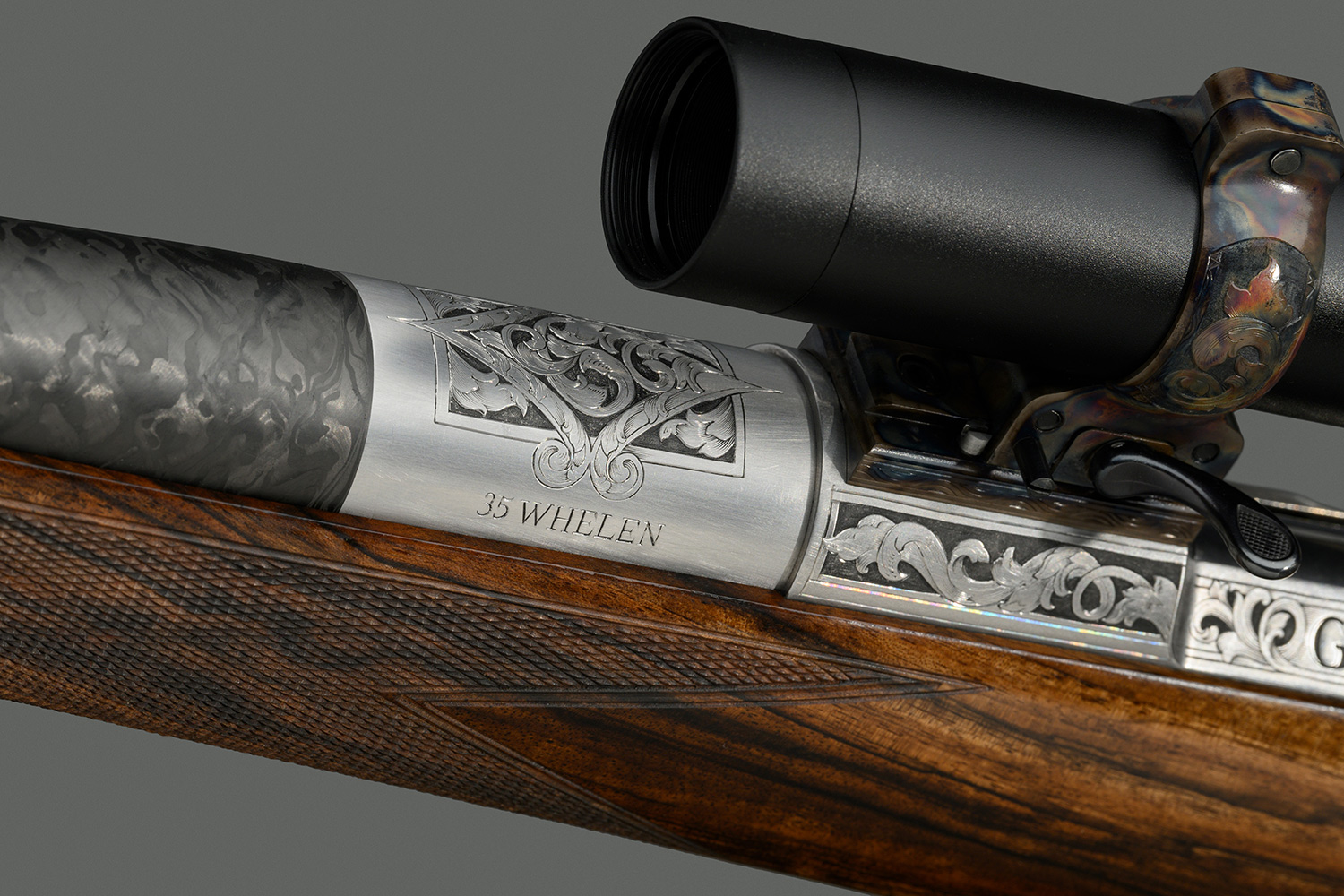
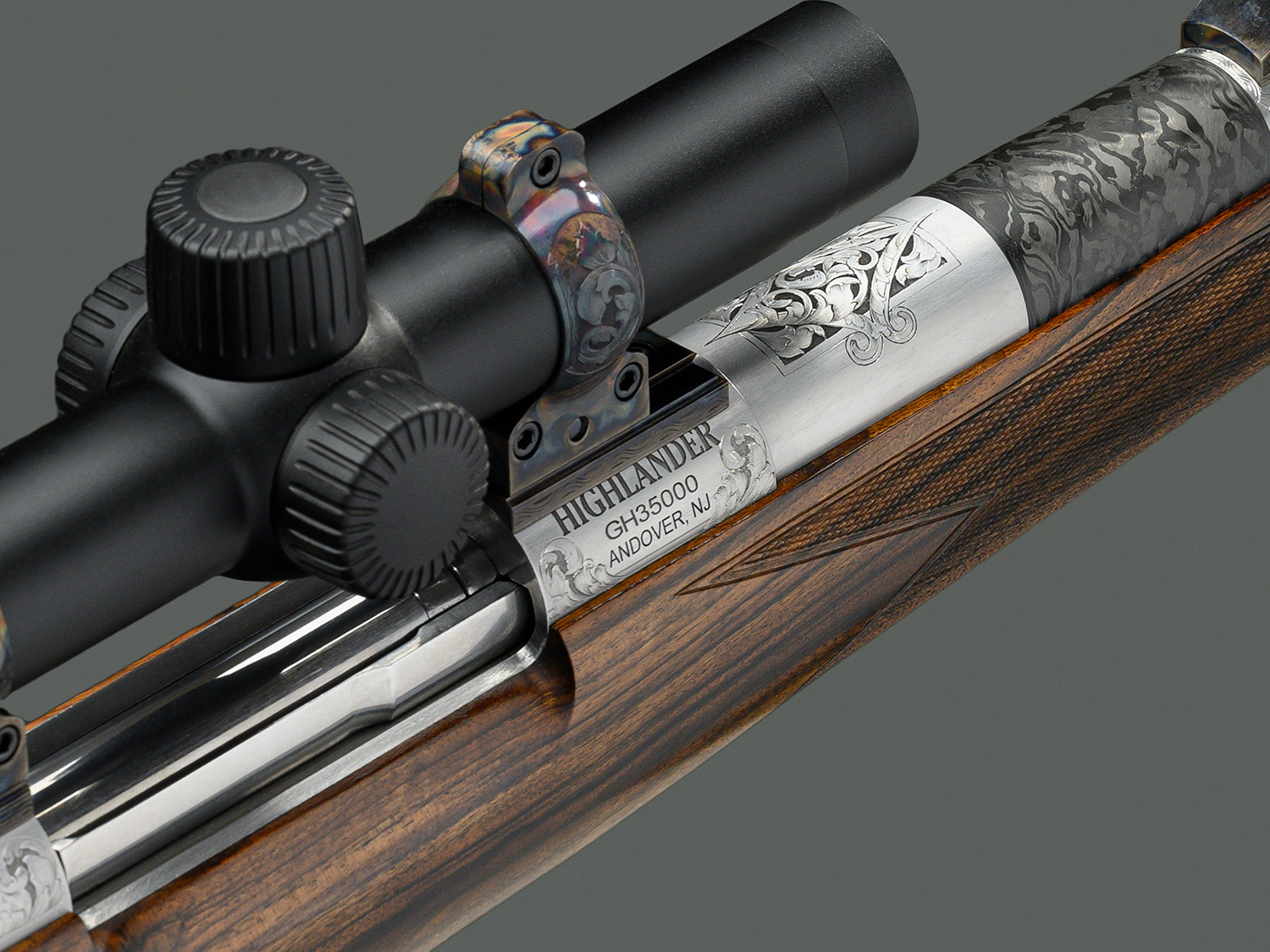

Flawless Fit and Finish
I handed the rifle at one point to a friend of mine in his early 30s who is an accomplished long-range shooter and knows his way around modern precision rifles—and, in fact, builds them for a living. But he’d never seen a rifle like this and was puzzled by the seamless fit between the stock and barreled action.
He asked whether that was normal, and it drove home how mating a stock and action this way has become a relic of another era. Free-floating barrels isn’t new—Whelen was advocating it decades ago—but it has become so ubiquitous that the old-school technique of tight stock fitting has all but disappeared.
That level of fit and finish is evident everywhere else on the rifle, too. The inletting around the bottom metal, the ejection port, the grip cap, the tang—all of it is done to less than a hair’s width of tolerance.
One thing worth mentioning is that the Torx-head guard screws are going to be replaced with proper slot-head fasteners soon. In the hurry to get the rifle ready for my hunt that small corner was cut.
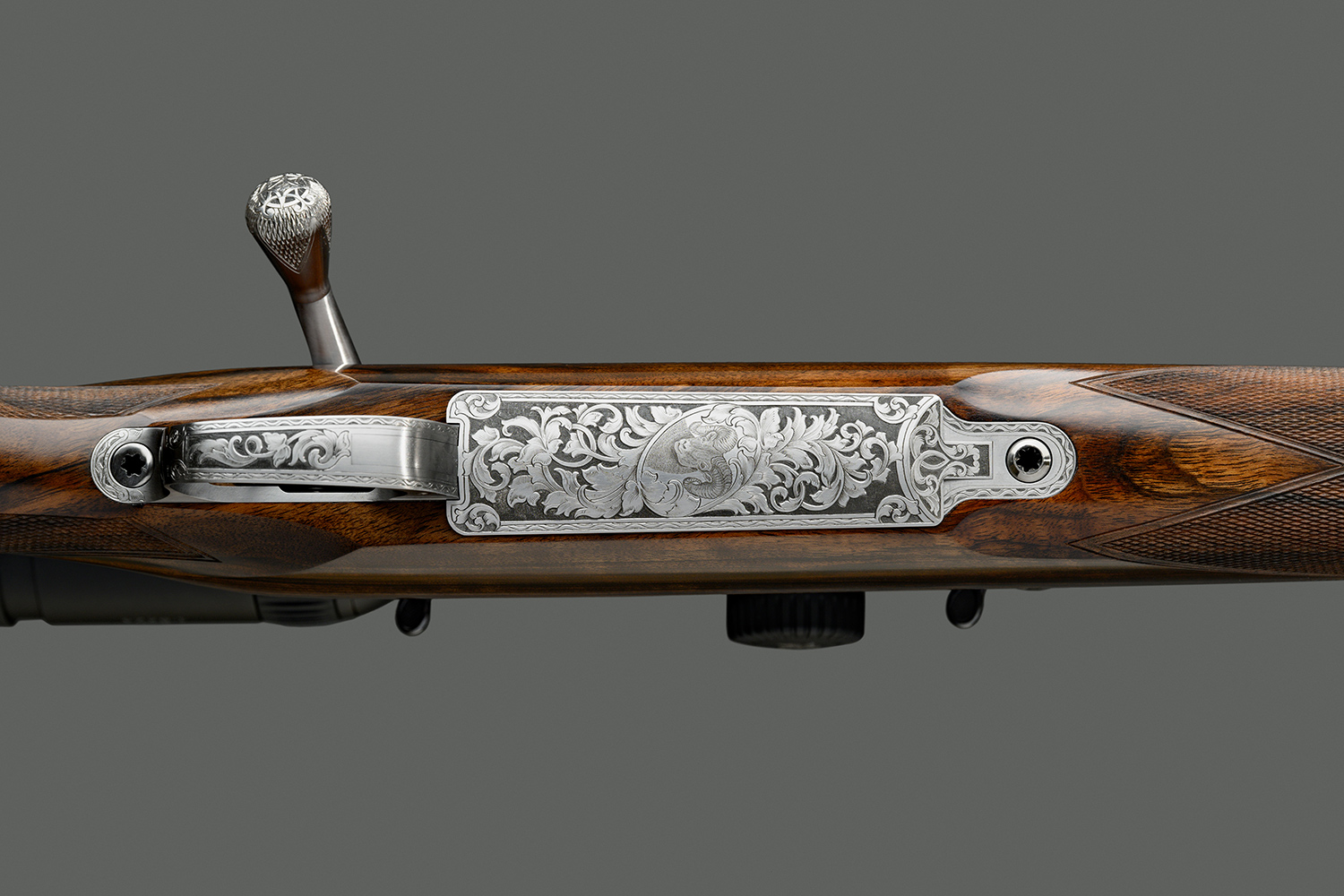

Next-Level Engraving
The wood stock and carbon-fiber barrel create the initial visual impression of the rifle, but as soon as you get close to it, what really stands out is the adornment on the metal.
One of the things that’s so appealing about this rifle is that it is a family affair. Chris Rossiter—brother of stock maker and shop foreman Dan—is also a member of the ACGG and did the engraving.
All told, Chris put 198 hours of meticulous handwork into the rifle using hammers and fine-pointed chisels that, depending on their shape and local custom, are known as burins, gravers, tints, or spitstickers. Every metal surface on the Highlander has some engraving and each is delightful to behold.
The engraving on the magazine floorplate is particularly intricate. It features a portrait of a bighorn sheep—which has been part of Griffin & Howe’s logo since day one—surrounded by vines and scrollwork and framed within a border consisting of elegant curving lines.
The vines and pattern of wavy lines is repeated on other sections of the rifle. The deep relief on the right side of the action is simply amazing, though, in fairness, that description applies to all the engraving.
From a personal standpoint, I also greatly admire the lettering on the rifle. The bold “Griffin & Howe” engraved on action is done in a gorgeous font that reflects the art deco aesthetic that was in vogue when the firm was founded in 1923.
Much of the rifle is still in the white, which really shows the engraving to full effect, but some elements have been color case hardened. The scope rings, scope bases, front and rear sights and grip cap got that treatment.
Mixing those colors and textures isn’t exactly traditional, but it does showcase Griffin & Howe’s rifle-building chops in a dramatic fashion.
Of course, no two of these rifles will be the same. Griffin & Howe is making only 10 of the wood and 10 of the composite stocked models, and each will be built according to the customer’s preference. That includes choice of wood, stock dimensions, type of recoil pad, and style and quantity of engraving.
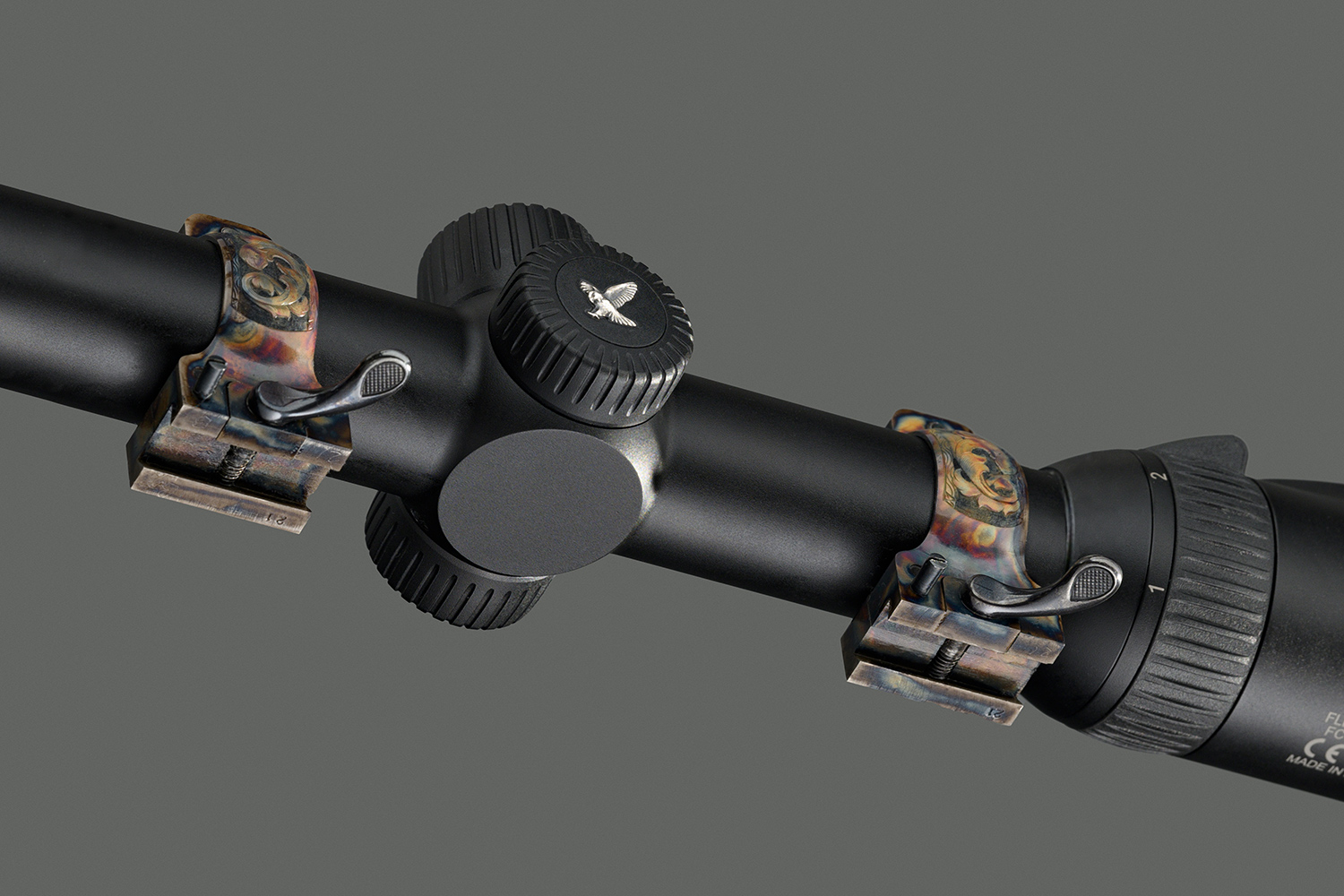
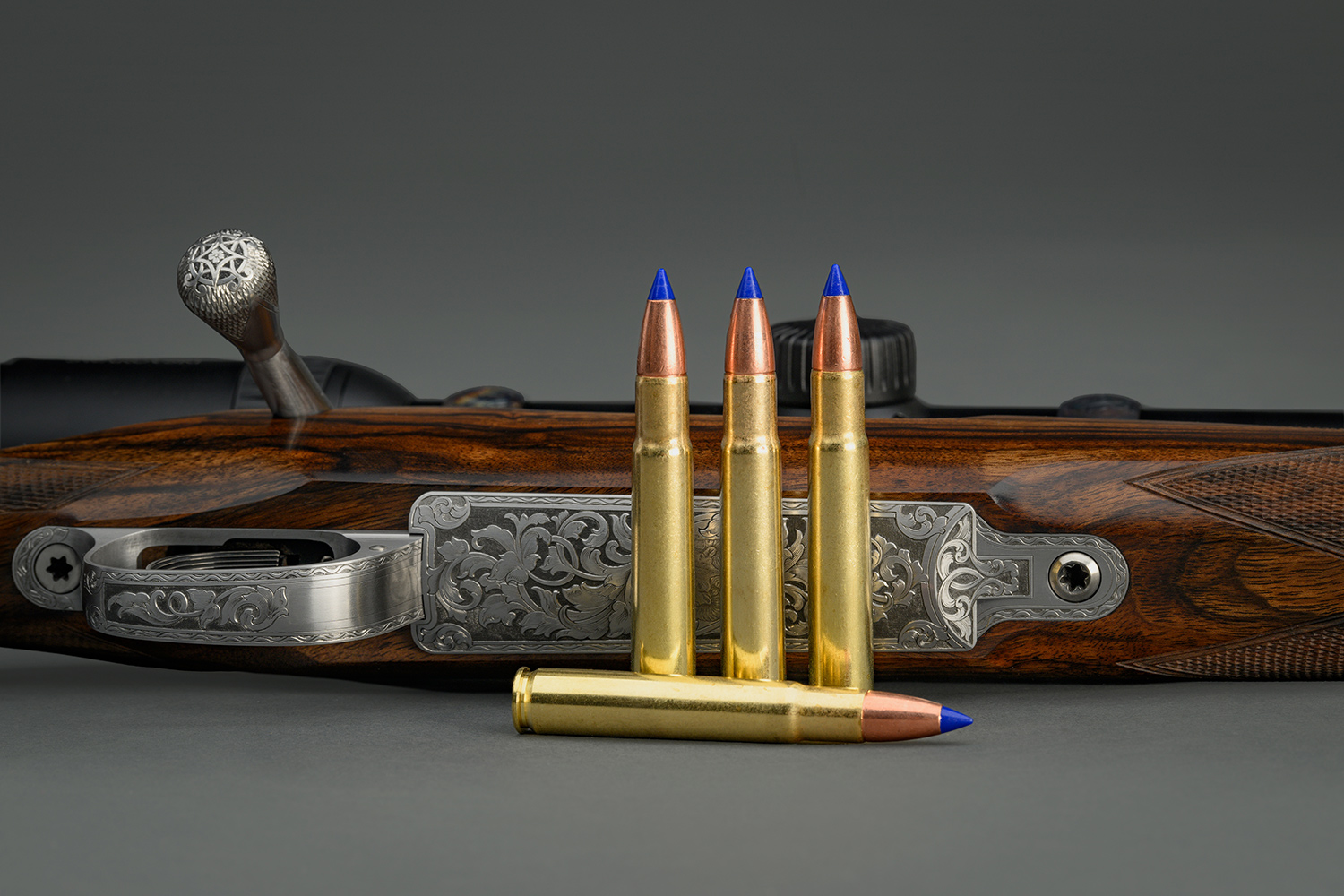
In the Field
In one of the more audacious moves of my career, I decided to take these Highlanders hunting. The wood stocked Highlander has a base price north of $20,000 and a bit more than that in the engraving, for a total cost of $44,000, give or take. By comparison, the synthetic stocked version is a budget gun at $12,400. I’ve never hunted with a pair of guns as costly, but that didn’t stop me from loading them into the back of my pickup and driving 1,000 miles north from Montana to a remote area near Alberta’s Lesser Slave Lake.
On the drive to camp I picked up Steven Polanish at the airport in Edmonton and we continued on our way to chase bears with John and Jenn Rivet, who own Livin the Dream Productions.
We spent a week in the woods, a thick mixture of poplars, birch, and spruce, watching bears from tree stands and ground blinds during the long northern evenings.
Polanish shot a bear of a lifetime during the hunt—a huge color phase cinnamon bear that squared more than 7½ feet. My bear, a 7-footer, was no slouch either.
It will come as no surprise to anyone who has experience with the .35 Whelen that the rifles and cartridge performed well. Both our bears were flattened with one shot and hardly moved.
The ammo we used was Barnes factory 180-grain TTSX FBs. The shots in this country aren’t far—anything more than 25 yards would qualify as a poke—so the bullets are carrying nearly every bit of their velocity upon impact. From the wood gun, muzzle velocity averaged 2941 fps, while the barrel on the synthetic gun was a touch faster at 2961 fps.
Those tough monometal bullets passed through both bears, leaving exit holes that indicated impressive expansion.
The recoil generated by the rifles is a bit more than what you’d get with a .30/06. Shooting 20 or 30 rounds at the range isn’t cumbersome, but with longer range sessions, the kick of the .35s will wear down your shoulder.
That’s the price, however, for a hard-hitting medium-bore cartridge like the Whelen, and that’s why it is an excellent choice for elk and other large game.
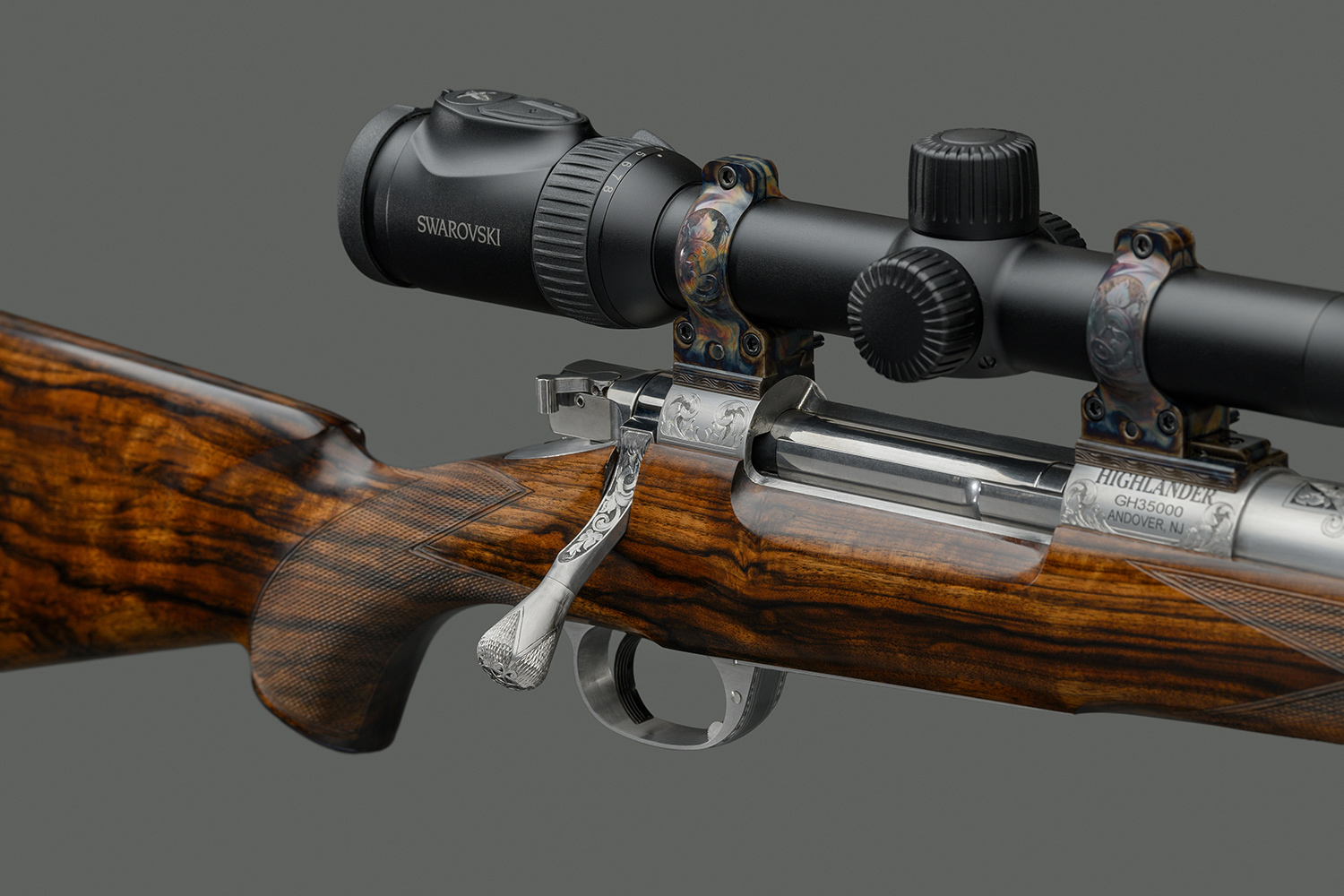
A Longstanding Legacy
With the creation of these rifles, Griffin & Howe has done an impressive job memorializing the milestone of their 100th year and the contributions Townsend Whelen made to their success.
In my own nod to tradition, I’m going to engage in the time-honored practice among gun writers of contrarianism.
Whelen got most things right, but when he said only accurate rifles are interesting, he missed the mark. Jim Carmichel and I discussed this point years ago over martinis, and we agreed that inaccurate rifles are often more interesting because they present a problem to be solved—and the process of coming up with a solution makes the gun writer’s profession fascinating indeed.
But whether a rifle is interesting hinges on more than if it places bullets in precise clusters, and I think these rifles are proof of that.
They are both accurate and capable of leveraging everything the .35 Whelen brings to the party in terms of exterior and terminal ballistics. But, really, that’s not the yardstick by which they should be judged.
They are expressions of the highest form of the traditional gunmaker’s art but executed with nods to modern trends and sensibilities that are surprising and refreshing to see. The blend of old and new contained within the format of barrel, action and stock that is as familiar to riflemen as their reflection in a mirror is a remarkable achievement.
I don’t know if I could change Whelen’s mind on his assertion. We ballistic scribes tend to stick to our guns, literally and figuratively. But if nothing else, he was always forward thinking with respect to rifles and marksmanship and had, dare I say it, a progressive mind when it came to innovation.
I know he would feel humbled and honored if he could hold and shoot these rifles. Despite his remarkable achievements, Whelen was never one to put on airs. And once he got a closer look and could see what went into their crafting, I’d be shocked if he didn’t say to himself, These are…interesting.
Read more OL+ stories.
